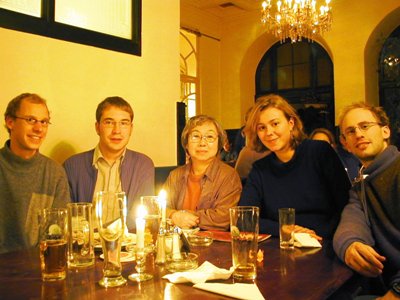2011年10月07日
31 Germany 2
Medical Students' Enthusiasm for Nuclear Abolition
The Bank of Japan building, located about 380m southeast from the hypocenter in Hiroshima, was three-storied and built of marble and ferroconcrete. It was a substantial building, which had 40-70cm thick walls. Thanks to the fact that the A-bomb was dropped before 9 a.m., when the bank opened, only the third floor, whose shutters were open, was damaged by the explosion and fire.
Ownership of the building was transferred to the City of Hiroshima and the building has been used for exhibitions and events held by individuals and groups. However, how to make use of it in the future is under discussion.
In July 2001, the Hibakusha in the World Exhibition was held in that building. I found a lean young man looking at each display with extremely eager attention, and talked to him. His name was Eckart Metie. He said he was a medical student of Munich University in Germany and came to Hiroshima during summer vacation to study at the Hiroshima University Research Institute for Radiation Biology and Medicine.
I told him that I am a hibakusha, and that I had missed seeing the clock tower of the City Hall when I visited Munich. We enjoyed small talk and said good-bye.
A few days later, I got a phone call from the World Friendship Center. They said that they were looking for a hibakusha who could go to Germany and attend workshops at his/her own expense in autumn. The workshops were to be held by medical students who belonged to the International Physicians for the Prevention of Nuclear War of Munich University. As I was to go to Sweden, they asked me to attend the workshops after that. To my surprise, the person who had requested some hibakusha to attend was Eckart. I always wanted to go to Dachau in the suburbs of Munich and accepted the request without hesitation.
On Nov. 16, when I visited the Dachau Concentration Camp, it was severely cold with sleet. The camp was a large area surrounded by barbed wire. After visiting the museum, I went out and found a concrete building beyond the cleared land. I fearfully entered it and saw many holes on the ceiling from which poison gas had been blown out. The holes were horrifying enough for me to imagine countless deaths of the Jews. The reverberating voice of the audio guide increased the desolation.
That night, I told my A-bombing experience at Munich University. Then we had a party, talking about nuclear problems over famous Munich beer. They said to me, "We will tell about Hiroshima here, so please tell about Dachau in Japan, Keiko." After I parted with them, I got on a train. I was so excited that I went beyond my destination. I was frozen at a ghost station in the snow.

(Having a meeting with medical students in Munich)

(To medical students in Munich)
- Permalink
- by HSO
- at 15:05
